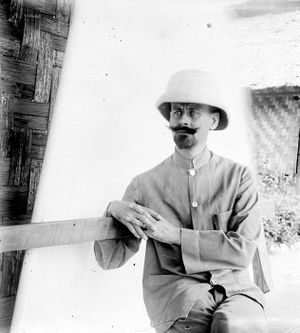Johannes Pieter Kleiweg de Zwaan
Contents
Notes
Office Notes
House Notes
1934.12.11 On the motion of the Treasurer seconded by Dr Harrison it was resolved to elect only two Hon. Fellows. The following were nominated: Dr Krause, Dr Mollison, Prof. Menghin, Prof. Thilenius, Baron von Eickstedt and Dr Kleiweg de Zwaan.
N.P. Kleiweg in 1949
1971.12 death noted
Notes From Elsewhere
Johannes Pieter Kleiweg de Zwaan ( The Hague , 4 July 1875 - Blaricum , 8 September 1971 ) was a Dutch physic anthropologist .
Kleiweg de Zwaan studied medicine in Leiden , then in Amsterdam and then also some time in Berlin and Paris . After his medical exam in 1903 he worked for a brief period as a ship's doctor and then as an assistant to the professors of internal medicine Pieter K. Pel and Pieter Ruitinga at the University of Amsterdam .
The request of the German ethnologist Alfred Maass in 1907 to Kleiweg de Zwaan to participate as a doctor in an expedition through Central Sumatra was seized by both hands. He conducted anthropological research at the Minangkabau , where he graduated cum laude in 1908. Through his participation in this expedition, Kleiweg de Zwaan left a life-long interest and love for the Dutch East Indies . Following the journey he traveled through Java , Bali and Lombok , but also through India and Japan before returning to the Netherlands, where he wrote his thesis at lightning speed.
In 1910 he returned to India to conduct extensive anthropological research on the island of Nias off the west coast of Sumatra. The inhabitants of Nias were known for their martial skills - heads were snapped - and their unique culture was very different from that of the island of Sumatra. Kleiweg de Zwaans detailed study of the Niassers, which was completed by making many plaster casts of their faces (now in the collection of the Utrecht University Museum ) was soon considered a classic of the then Dutch physical anthropology.
His third major study trip led him to Bali and Lombok in 1938, where he examined the physical differences and similarities between the different population groups. The people were also systematically photographed by his wife, who assisted him scientifically,
Kleiweg de Zwaan was private tutor in the medical history of culture at the University of Amsterdam when he was invited in 1915 by one of the board members of the newly established Colonial Institute in Amsterdam (now Royal Institute for the Tropics ) to join the anthropologist in order to "Design and development of subsection Physical Anthropology". He remained employed as a paid staff member until 1927, but as an "honorary anthropologist" he actually led the subdivision until 1948. Because of the Colonial Institute he became professor in anthropology and medicine in 1919 at the University of Amsterdam. from the Dutch East Indies. In 1924 he also became extraordinary and in 1932 became a full professor in anthropology and prehistory, a post he held until 1939.
Kleiweg de Zwaan was a passionate networker and he played a central role at the administrative level of his field. He was secretary and later chairman of the Royal Dutch Geography Society , co-founder and long-time chairman of the Dutch National Anthropology Bureau and one of the founders and editors of the magazine Mensch en Maatschappij . In 1927 he was the driving force behind a large international congress in Amsterdam, which was founded by the French Institut International d'Anthropologie , and in 1938 from an international congress, also in Amsterdam, which was organized by the Geography Society.
The threat of a new world war brought him to his academic positions shortly before his retirement in 1939. In the Tropics Institute he was succeeded in 1949 by the physical anthropologist Rudolf Bergman .
During his long career, Kleiweg de Zwaan became more and more interested in other disciplines, such as prehistory, ethnology , folklore and tribal art. But the core of his scientific oeuvre remained the comparative anatomy of large populations, especially those of the Dutch East Indies and Dutch New Guinea . With the methods of anthropometry and especially craniometry , he tried, like most of his colleagues at that time, to establish or reconstruct racial characteristics, racial blending and historical migrations of peoples. This application of physical anthropology has not only fallen into disuse due to later scientific developments - including through the discovery of the DNA - but also brought into disrepute by the political developments in Germany during the interwar period where research into 'races' degenerated into a pseudoscientific racial doctrine , which had to establish the alleged inferiority of Jews and Gypsies , among other things, with all its consequences. The anthropological oeuvre of Kleiweg de Zwaan is now only of scientific-historical importance.
Publications
External Publications
Contribution to the anthropology of the Menangkabau-Malays . Amsterdam (diss. UvA), 1908.
Anthropological Untersuchungen über that Niasser . The Hague, 1914.
Kraniologische Untersuchungen niassischer Schädel . The Hague, 1915.
"The relation to the family in the Indian Archipelago, in: Contributions to the Language, Land and Ethnology of the Dutch East Indies 74, 1918, pp. 519-561.
Anthropological bibliography of the Indian archipelago and of the Dutch West Indies (Encyclopaedic Bureau, Afl. XXX). Batavia-Weltevreden, 1923.
The races of the Indian archipelago . Amsterdam: Meulenhoff, 1925.
Palaeolithic art in Europe , 2 dl. Amsterdam: Paris, 1929-1930.
The dwarf colonies (anthropological) . The Hague: Servire, 1942.
Anthropological Untersuchungen on Bali and Lombok (Med Dept. of Ethnology of the Colonial Institute, extra series No. 14). Amsterdam, 1942.
Objective and development of anthropology . The Hague: Servire, 1943.
The oldest humanity of the Indian archipelago . The Hague: Servire, 1943.
"The Papuans of Dutch New Guinea, a Physico-Anthropological Survey", in: Antiquity and Survival , No.5, 1956, pp. 321-342.
The oldest humanity in Europe and Indonesia (anthropological) . The Hague: Servire, 1956.
